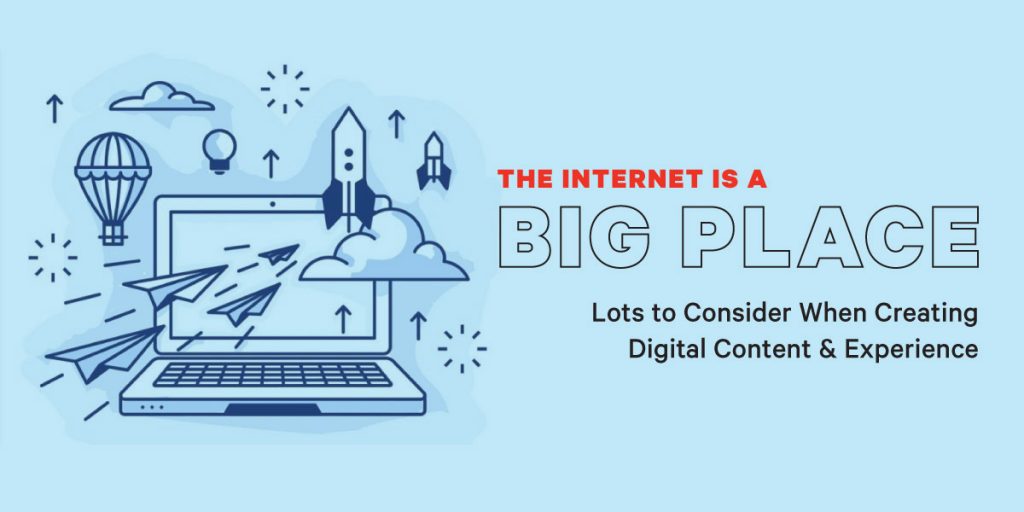The Internet is a Big Place

Lots to Consider When Creating Digital Content and Experience
Way back when the World Wide Web was invented and people actually used that term to describe it, companies were lucky to have a simple website. In those days, links were blue, pages were gray and Google hadn’t even launched. The digital experience consisted of the equivalent of a clickable business card, with a grainy photo or two thrown in for effect.
Websites have evolved as a core piece of building a brand’s digital experience. Built correctly, they serve as a critical place for companies to communicate with existing or new customers, and they can be enhanced with videos, tools to provide customer service and even an online store to provide e-commerce. They are also source material for search engines like Google and Bing that serves billions of results to people seeking information.
And the complexity of websites isn’t the only big change. Companies have a wide range of other digital tools to consider. There are social channels, acting as little outposts on Facebook, Instagram, LinkedIn, Twitter, Tik-Tok and others. There are videos and podcasts and other multimedia channels. Newsletters and e-mail marketing remain a surprisingly resilient way of keeping in touch or finding new customers. Layer paid digital marketing on top of all of those free methods and you have an exciting (if challenging) environment.
The Abbi Agency’s Digital Content and Digital Experience teams specialize in the ever-changing mysteries of search-engine optimization, user experience and social strategy. If done correctly, it is more art than science, and our team’s experience and ingenuity keep us in business. But we also have some guiding principles which we’re happy to share.
It Still Mostly Starts With A Website
While brands now have more ways than ever to reach customers, a well-designed and maintained website is something you can completely control and optimize to deliver answers to existing or future customers.
First, it’s important to consider the User Experience (UX) of your website. This isn’t about how your website looks — that’s coming later. This involves thinking through the problems you’re trying to solve and the answers you want to provide. Why would someone come to your website in the first place? Yes, they have the option of emailing you or calling, but maybe it’s 11 p.m. or they’re shy and they want their answer now. Think about the kinds of questions new or existing customers ask and make sure your website contains those answers. Other basic information to include:
- The home page should quickly communicate exactly what your business does.
- You’d be amazed how many companies forget to include basic contact information (geographic location, phone number, e-mail address or form, etc.).
Next, you can think about User Interface (UI) considerations. Yes, this involves how your website looks, how many images you use and how content is displayed. Less is more. Even though visitors have higher bandwidth than ever before, more and more are accessing your site through a phone, where speed and interface matters.
Make sure your site displays well both on desktop (through multiple platforms and browsers) and on mobile devices (again, multiple platforms and browsers). Google even judges sites based on how well they rank using the company’s Mobile-Friendly Test. Organic, or free, search results are based on how well your site works, so paying attention pays off.
There’s a lot more to say about UX and UI and how to build your website, and we’ll continue to post more information about that here. Which leads to the next topic, which is maintaining your site. In addition to keeping up with changes to browsers, design theory and new devices, it’s important to keep your site’s content fresh. It gives people a reason to revisit your site and provides search engines with a reason to visit and index your content on a frequent basis, instead of once a year.
How do you do that? A blog like this one is a great example. We follow the Pillar Page methodology as explained on Hubspot’s site. Build out a page on a general topic that covers lots of sub-topics (like the one you’re reading now) — that’s your Pillar Page. Continue to develop sub-pages that further explain information from that Pillar Page. The goal is to:
- Provide site visitors with new information on a regular basis.
- Give search engines a reason to visit and great content to index.
- The creation of content which you can reuse through your social channels, newsletters, podcasts, advertising and more.
Continuing the Conversation
Websites and their capabilities have certainly evolved since the first crude pages arrived more than 30 years ago, followed shortly by the first widely used browsers. But even more exciting is all of the other ways companies can now use the Internet to explain their brand and engage with existing or future customers. At The Abbi Agency, we’ve become expert in all of these since they are constantly changing. Here’s a brief overview, along with some tips you can use to grow your own business.
Social media is probably one of the most exciting and evolving channels. It’s important to realize that there isn’t a single way to engage on social media – each channel has its own set of best practices and audience type. Also, each social network has unique strengths when it comes to delivering on business goals. Briefly:
- Facebook: The largest social site with 2.6 billion monthly active users (MAU). Older audience, split evenly male-female. Very conversational and interactive. Improving at delivering direct marketing-type results or e-commerce conversions, but not the best.
- YouTube: Second-largest with 2 billion MAUs, delivers video. Wide audience, skews male. Not as interactive as Facebook – geared more toward people seeking information, more like a video search engine. Requires proficiency to create video (more on this below). Another site geared more toward awareness than direct response results.
- Instagram: Third-largest with 1.1 billion MAUs, delivers images. Younger audience, skews female. Again, not as interactive as Facebook (who happens to own Instagram), more of a browsing/entertainment interface. Better than others at delivering e-commerce and direct results.
- Pinterest: Fourth-largest (but still 367 million MAUs) and the most niche of the group. Used for discovery, visual sharing, collecting and searching – almost a visual search engine and repository. Skews older and overwhelmingly toward women (71 percent of all Pinterest users). Poor advertising tools, but underutilized and more affordable than some of the others.
- Twitter: Fifth-largest with 326 million MAUs. Push-driven, where users post information and others interact. Can be one of the more combative platforms, audience fairly diverse from an age and demographic perspective. Also has poor advertising tools and is mostly useful for branding or communication with new or existing customers.
There are others, of course. TikTok, which in January 2018 had 54 million global users, now has nearly 800 million (100 million in the United States). LinkedIn has a smaller reach with 260 million MAUs but is built for business, and is a highly effective business-to-business channel for communicating with employees and fellow companies and sharing corporate information.
As we mentioned, each social channel has its own personality and norms. You’ll hear a lot about authenticity when it comes to establishing a presence on social. Check out our recent advice on how to manage your social channels during a crisis like COVID-19. Do you need to have a presence on every social channel? Probably not. Look for platforms where your customers already congregate and where you can provide value and contribute to community. Basic rules to remember include:
- If you build it and you want people to visit, have a plan in place to maintain and update your page.
- Learn more about each channel and how people communicate. The voice is more formal on LinkedIn, less formal on Instagram.
- Be prepared to have critics, and have a plan on how to work with them. It’s a conversation – you shouldn’t just ignore a comment because it’s negative.
- It isn’t all about you. While it’s OK to tout your company, people will only maintain interest if there’s something in it for them. Share information, take a position and give social users a reason to care and pay attention.
More Ways to Share Your Story
As you can see, there are countless ways to use digital tools to communicate with new and existing customers, employees and other companies. We’ll close with one tactic that predates web pages and two others that have exploded in recent years.
E-mail newsletters have been around since the late 1970s, long before even the most basic web page had been thought of or created. While e-mail newsletters have become incredibly sophisticated, the basics still apply: One party is willing to provide an e-mail address, and it’s up to the other party (you) to deliver something worthwhile in exchange.
Today, e-mail newsletters remain incredibly resilient and effective even though they are one of the oldest forms of digital marketing communication. But that doesn’t mean they’re all created equally. Some tips:
- Make sure you contact people on a regular basis. If you say it’s a weekly newsletter, send it every week. You determine the frequency, but stick to the schedule.
- As with social media, make sure there is something for the subscribers. If it’s news about your business, write your messaging in a way that describes benefits other clients would want to achieve.
- Use the data wisely. Don’t send too many messages, don’t send irrelevant messages, don’t sell people’s names to other companies.
While e-mail newsletters have been around forever, online video only took off in the past few years. E-mail video became popular when bandwidth became more plentiful both to phones and to computers, platforms emerged to display and share video and phones became handheld movie studios.
There are countless ways you can utilize video, including on each of the digital channels we’ve already talked about. Each have their own requirements in terms of audience, how professional the video should or should not be, viewing length and more, but the same general rules apply. Yes, video is a great and continually evolving way to tell your story. But make sure you remember the audience.
The final channel we’ll discuss is one that has erupted in the last year or two: podcasts. The format, where a host either provides commentary or interviews guests, has been around for a while. But with better apps for managing podcasts on phones (either as a standalone solution or through Spotify or other streaming services), teamed with the increased prevalence of Bluetooth in cars, both the listening audience and variety of content has erupted.
Yes, The Abbi Agency has a podcast (give it a listen!) and we produce them for our clients (Nevada State Sen. Ben Kieckhefer’s Across the Aisle is an example).
Some podcasts are professionally produced with soundtracks and high production values; others are a person talking into the recording app on their phone. As with much of the digital content we’ve reviewed, the quality is what draws and keeps an audience.
So there you have it: A snapshot of the world of the state of Digital Content and Experience in 2020, along with tips on how to best position and present your business. The digital world has changed substantially since those early websites launched. And, rest assured, it will all change again.
Addendum: Don’t Forget to Track It
While we touched upon the topic of tracking in each of the sections above, you’re wasting your time building experiences and content if you don’t monitor your results.
- For your website, install Google Analytics if you haven’t already done so. It’s free, it’s comprehensive, and even if you don’t completely understand all of the reports, when you either hire an employee or an outside firm to help, they’ll thank you for the historical data.
- Take some time to learn the tools that are available within the platforms we discussed. From email systems to social networks, you can see who is seeing and interacting with your content.
- Consider an audit. Each of these platforms and tracking solutions will provide lots and lots of data and reports. It can be helpful to have an outside company come in, take a look, and provide you with custom recommendations on how to use it to improve your results and your business. We know what we’re talking about – The Abbi Agency does audits on website UX/UI, media buying, social media best practices, public relations and more.



